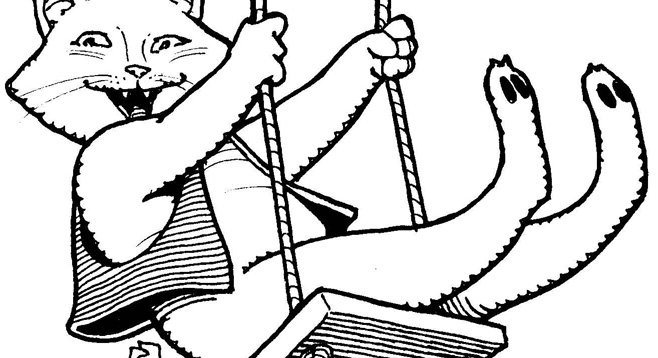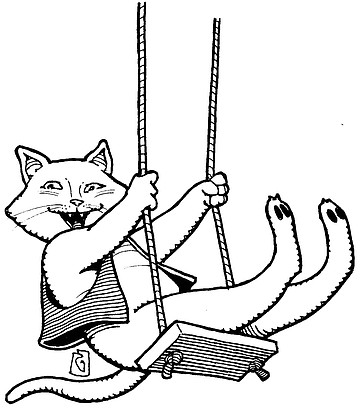 Facebook
Facebook
 X
X
 Instagram
Instagram
 TikTok
TikTok
 Youtube
Youtube

Heymatt: My mother stopped by to see my new apartment and she said, “There’s not enough room here to swing a cat.” I’ll admit the place is sort of cozy, but why would anyone want to swing a cat in it? I’ve heard the expression before, so it’s not something my mom just made up. Can you find out where the expression came from and why anybody would want to swing a cat in the first place? — Cat Lover, San Diego

Historically, cats have had their ups and downs. In ancient Egypt they were worshipped, in the Middle Ages and later they were feared and hated. Today we feed them beef tips in wine sauce out of crystal compotes. So cat-swinging is at least a possibility. As for the expression, well known by the mid-1600s, the most common explanation you’ll hear is that “cat” refers to the cat-o-nine-tails that the British Navy used to discipline crew members. The crew cabin was too small to properly swing the cats for maximum effect, says this crowd of word wizards. No, no, say the nonbelievers. The British Navy always flailed the cat on deck, with the bad guy tied to the mast, so all crew members assembled to watch could benefit from this teachable moment. And Britain didn’t start doing this until after the expression was known.
Further research into the checkered history of the cat revealed that hunters, at the end of the day, would retire to the nearest ale house and swing cats. Often the animals were placed in bags and swung over a ceiling beam, then perhaps shot at. Other times, two cats would be tied together with a rope; then the hunter would attempt to fling the cats over a beam, one cat on each side. Much fun, apparently, for a crowd that had just spent the day killing Bambi and bunnies. The saloon cat games are actually referred to in literature of the times: David Copperfield and one work of Shakespeare. Which story you believe seems to depend on how strongly you think the Navy tale is pure bunk.
Hey Matt: I always like looking at the ground while walking to find money, roaches, etc. I noticed on O.B. pier that about every five feet or so a marble is embedded in the cement. Why is this? — Alex J. Vejar, CA Dept. of Fish & Game
This I think is a perfect O.B. question with the perfect O.B. answer. For leads, we went to (Ms.) Denny Knox, exec director of the O.B. MainStreet Association, and (Mr.) Pat James, chair of the O.B. Historical Society. No one knows, they say. It’s a mystery, despite attempts to unmask the perp. But, of course, there are plenty of tales. Denny Knox keeps an informal brain file of marble rumors, which includes these. A woman in her 60s is embedding them, though no one knows who she is or why she’s doing it. A woman in her 60s would probably have been in the hippie mix that was the O.B. we all knew and loved, so this isn’t so outrageous a tale. In the category of Physically Impossible is the rumor that someone with a gun is shooting the marbles into the concrete surface. And, of course, many believe the original concrete pourers threw marbles into the mix. This last story’s not likely to be true, since it’s well known that the marbles appeared a decade or two after the pier was built. Could 10 or 20 years of fishermen’s feet have worn away the concrete and revealed the marbles underneath?
On the outside chance that the “artist” who felt the pier could use a little brightness wants to ’fess up, s/he is welcome to check in with us and reveal all. Actually, the pier’s 50th birthday will be in 2014. Maybe that would be the time to pop out from behind the curtain and take credit. Personally, I think the marble mystery fits right in with the O.B. zeitgeist and maybe is best left unsolved.
Heymatt: What is with the sudden closing of a lot of the ARCO gas stations around the San Diego area? (An inquiry from me to ARCO did not get a reply, so maybe you can find out.) — Dale Dickerson, via email
Too bad, the loss of a reliably cheaper herd of gas stations around town. It’s the result of big-time economics and the genealogy of what we took to be just a friendly group of vendors. The Arco (and the Thrifty) brand is owned by the dreaded BP (British Petroleum), the same BP responsible for the oil-rig disaster in the Gulf of Mexico. Well, “was” owned. On the hook for all costs related to the physical, economic, and public-image rehab of the Gulf area, BP has sold about 250 of its many Arco stations in Southern California to Texas refiner Tesoro. Expect Tesoro’s USA Gasoline in Arco’s place. It’s complicated; there might be more on the horizon.


Heymatt: My mother stopped by to see my new apartment and she said, “There’s not enough room here to swing a cat.” I’ll admit the place is sort of cozy, but why would anyone want to swing a cat in it? I’ve heard the expression before, so it’s not something my mom just made up. Can you find out where the expression came from and why anybody would want to swing a cat in the first place? — Cat Lover, San Diego

Historically, cats have had their ups and downs. In ancient Egypt they were worshipped, in the Middle Ages and later they were feared and hated. Today we feed them beef tips in wine sauce out of crystal compotes. So cat-swinging is at least a possibility. As for the expression, well known by the mid-1600s, the most common explanation you’ll hear is that “cat” refers to the cat-o-nine-tails that the British Navy used to discipline crew members. The crew cabin was too small to properly swing the cats for maximum effect, says this crowd of word wizards. No, no, say the nonbelievers. The British Navy always flailed the cat on deck, with the bad guy tied to the mast, so all crew members assembled to watch could benefit from this teachable moment. And Britain didn’t start doing this until after the expression was known.
Further research into the checkered history of the cat revealed that hunters, at the end of the day, would retire to the nearest ale house and swing cats. Often the animals were placed in bags and swung over a ceiling beam, then perhaps shot at. Other times, two cats would be tied together with a rope; then the hunter would attempt to fling the cats over a beam, one cat on each side. Much fun, apparently, for a crowd that had just spent the day killing Bambi and bunnies. The saloon cat games are actually referred to in literature of the times: David Copperfield and one work of Shakespeare. Which story you believe seems to depend on how strongly you think the Navy tale is pure bunk.
Hey Matt: I always like looking at the ground while walking to find money, roaches, etc. I noticed on O.B. pier that about every five feet or so a marble is embedded in the cement. Why is this? — Alex J. Vejar, CA Dept. of Fish & Game
This I think is a perfect O.B. question with the perfect O.B. answer. For leads, we went to (Ms.) Denny Knox, exec director of the O.B. MainStreet Association, and (Mr.) Pat James, chair of the O.B. Historical Society. No one knows, they say. It’s a mystery, despite attempts to unmask the perp. But, of course, there are plenty of tales. Denny Knox keeps an informal brain file of marble rumors, which includes these. A woman in her 60s is embedding them, though no one knows who she is or why she’s doing it. A woman in her 60s would probably have been in the hippie mix that was the O.B. we all knew and loved, so this isn’t so outrageous a tale. In the category of Physically Impossible is the rumor that someone with a gun is shooting the marbles into the concrete surface. And, of course, many believe the original concrete pourers threw marbles into the mix. This last story’s not likely to be true, since it’s well known that the marbles appeared a decade or two after the pier was built. Could 10 or 20 years of fishermen’s feet have worn away the concrete and revealed the marbles underneath?
On the outside chance that the “artist” who felt the pier could use a little brightness wants to ’fess up, s/he is welcome to check in with us and reveal all. Actually, the pier’s 50th birthday will be in 2014. Maybe that would be the time to pop out from behind the curtain and take credit. Personally, I think the marble mystery fits right in with the O.B. zeitgeist and maybe is best left unsolved.
Heymatt: What is with the sudden closing of a lot of the ARCO gas stations around the San Diego area? (An inquiry from me to ARCO did not get a reply, so maybe you can find out.) — Dale Dickerson, via email
Too bad, the loss of a reliably cheaper herd of gas stations around town. It’s the result of big-time economics and the genealogy of what we took to be just a friendly group of vendors. The Arco (and the Thrifty) brand is owned by the dreaded BP (British Petroleum), the same BP responsible for the oil-rig disaster in the Gulf of Mexico. Well, “was” owned. On the hook for all costs related to the physical, economic, and public-image rehab of the Gulf area, BP has sold about 250 of its many Arco stations in Southern California to Texas refiner Tesoro. Expect Tesoro’s USA Gasoline in Arco’s place. It’s complicated; there might be more on the horizon.
Comments